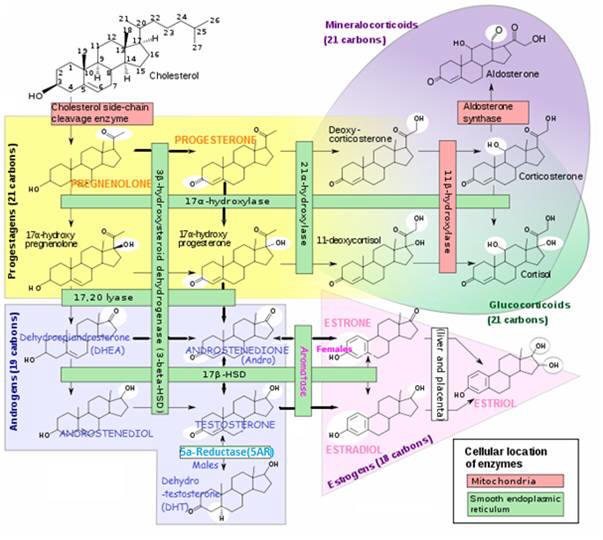
Estrogens are a subclass of the sex steroid hormones. Also includes androgens and progestagens
Hormones 101 -"Feel Good, Look Good"
The 3 most significant estrogens are produced from androgens through the action of enzymes:
ESTRADIOL (E2, 17β-ESTRADIOL)
ESTRONE (E1)
Changing levels of these estrogens could be instrumental in tissue development, function, and some lifestage-specific diseases in women
Fluctuate with life stage. Suggesting specific roles for them in biological and disease processes. Fluctuations of ovarian hormones in perimenopause consist of intermittent high and low ESTRADIOL (E2 levels, followed eventually by chronically lower levels, and the predominance of ESTRONE (E1). These changes can be correlated with behavioral and other disturbances and pubertal and menstrual cycle-based fluctuations.
Produced by aromatase enzymes in non-reproductive tissues (E.g. brain, fat cells). With possible effects on non-reproductive functions.
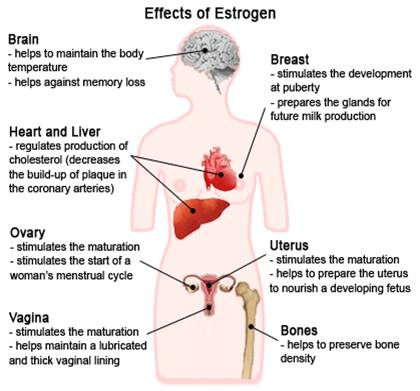
| Estrogen (mainly ESTRADIOL) has numerous effects in the body | |
|---|---|
Sex Differentiation |
▪ Promotes formation of female secondary sex characteristics: growth of a girl's sex organs, breasts and pubic hair. |
| ▪ Effeminization when estrogen to TESTOSTERONE ratio increases. E.g. Breast growth, higher voice, loss of body hair, decrease in muscle mass, increase in fatty tissue, prostate enlargement, change in sex drive; | |
Protein Synthesis |
▪ Estrogen action: The role of specific RNA and protein synthesis; |
Reproductive Functions |
▪ Decreases libido (sex drive); ▪ Helps regulate menstrual cycle; ▪ Stimulates endometrial growth; ▪ increases uterine growth; ▪ ESTRIOL produced by placenta is involved with maintaining pregnancy and initiating labor. ▪ Breast-feeding stimulates estrogen production - which stimulates production of the PROLACTIN hormone to increase milk production. |
| ▪ ESTRADIOLmodulates sex drive, erectile function and spermotogenesis in men - for libido, estrogen is to men what TESTOSTERONE is to women. Estrogen receptors and aromatase (enzyme that converts testosterone to estrogen) are abundant in brain, penis, and testes, organs important for sexual function. In the brain, ESTRADIOL synthesis is increased in areas related to sexual arousal. PubMed | |
Reproductive organ cancers |
▪ Promotes hormone-sensitive reproductive organ cancers
-
treatment of endometrial and breast cancer involves suppression of
estrogen production;
ESTRADIOL promotes an oncogene, Bcl-2 (expressed
at high levels, oncogenes help turn a normal cell into a tumor cell). ▪ ESTRADIOL increases expression of genes that are responsible for directing production of both androgen and estrogen hormone receptors. |
Regulates Fluid balance |
▪ Regulates salt / water retention; ▪ Increases growth hormone; ▪ Increases CORTISOL, SHBG (Sex-Hormone Binding Globulin) -binds ESTRADIOL (and TESTOSTERONE) in blood and thus inhibits their bioavailability, since only "free"hormones are active) |
Structural |
▪ Accelerates height growth; ▪ Reduces muscle mass; ▪ Maintains blood vessels /skin; |
Shortened height |
▪ Can cause early epiphseal closure near the end of puberty - thus limiting height |
Protects against heart disease / Blood Clotting |
▪ Increases HDL & triglycerides / Decrease LDL & fat deposition in coronary arteries;▪ Blood Coagulation - Increase circulating level of factors 2, 7, 9, 10, antithrombin III, plasminogen / Increase platelet adhesiveness |
GI Tract |
▪ Reduces bowel motility; ▪ Increases cholesterol in bile; |
Lungs |
▪ Promotes lung function by supporting avioli |
Preserves bone density |
▪ Helps decrease bone loss slightly - by slowing bone resorption (osteoclast activity); antagonizes the effects of PTH, minimizing the loss of calcium from bones, |
Decreases fat burning |
▪ Increases subcutaneous fat deposits/decreases fat-burning by stimulating SNS. As an Alpha 2 adrenergic agonist, estrogen increases / activates Alpha2 adrenoceptors (A2As), which inhibit fat burning (A2As react to neurotransmitters EPINEPHRINE, NOREPINEPHRINE, and isoprenaline, for a sympathetic effect; NOREPINEPHRINE is one of the body's primary fat burning agents), but when estrogen binds to the A2A (taking NOREPINEPHRINE's "seat"), it creates a negative feedback loop inhibiting the release of fat-burning NOREPINEPHRINE. |
Melanin |
▪ Increases pheomelanin, reduces eumelanin |
Anti-aging for Skin |
▪ Prevents decrease in skin collagen in post-menopausal women. Topical and systemic estrogen therapy with ESTRIOL increases skin collagen content / skin thickness / skin moisture (increases acid mucopolysaccharides and hyaluronic acid, and possibly maintains stratum corneum barrier function); Possible anti-wrinkle effect on elastic fibers; See: ESTRIOL-The WEAK, Protective Estrogen |
The physiological effects of estrogens are mediated by the intracellular estrogen receptors (ERs) . In response to , xenoestrogens and signals emanating from growth factor signalling pathways, they regulate:
Specific effects of estrogens depend on:
ESTRONE (E1) and ESTRIOL (E3) are:
ESTRADIOL(E2) is:
The female ovaries are not the only source of estrogen - which is also produced by the metabolic activity of certain enzymes in adrenal glands, fat, skin, and many other peripheral sites :
ESTRADIOL production is under the cyclical endocrine control of two PITUITARY gonadotrophins, LH and FSH, which are released by hypothalamic GnRH (which is subject to negative estrogen feed-back from the ovaries)
By negative-feedback - high-level Estrogen causes a decrease in FSH/LH production by inhibiting hypothalamic GnRH (Gonadotropin Releasing Hormone) production.
FSH/LH ▲→ Estrogen ▲
Estrogen ▲▲▲ → GnRH ▼ → FSH/LH▼→ Estrogen ▼
(Rising levels of estrogen in the blood begins follicle/egg development)
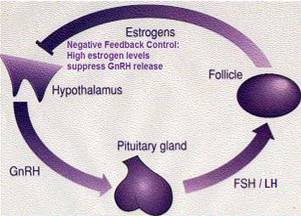
Luteinizing hormone (LH) - binds with LH receptors to stimulate follicle thecal cells to produce mainly ANDROSTENEDIONE, which is supplied to the neighboring follicle granulosa cells as a substrate with which to make ESTRADIOL;
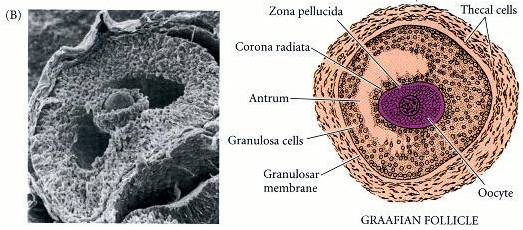
Follicle-stimulating hormone (FSH)
The rise in ESTRADIOL causes expression of LH receptors ▲ on maturing follicles, which also indirectly increases ESTRADIOL▲ production. By stimulating theca cells to provide more substrate ANDROSTENEDIONE. ESTRADIOL continues its positive feedback loop supplying LH receptors for LH activation to provide more ANDROSTENEDIONE substrate for additional estrogenproduction, until high estrogenlevels inhibit hypothalamic GnRH,causing a decrease in FSH production and a subsequent decrease in estrogenproduction;

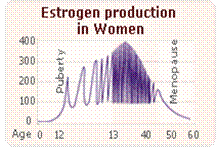
Estrogen Production Site Chart |
||||
|
Who ? |
Estrogen Names |
Production Sites (by aromatase enzyme) |
Aromatase produced in response to: |
Comments |
| Reproductive Age Women |
ESTRADIOL (E2) (17-beta ESTRADIOL)(circulating hormone) |
Ovaries (granulosa cells) | FSH | ▪
ESTRADIOL functions as a circulating
hormone (acting on distant target tissues) - Most abundant and potent natural form of estrogen in non-pregnant females during reproductive years. ANDROSTENEDIONE from ovarian theca cells or adrenal cortex is principal substrate for production of ESTRADIOL in ovarian granulosa cells. |
| Men and Women |
ESTRONE (E1) ESTRADIOL (E2)(Localized metabolism) |
Adipose tissue(mesenchymal cells) Bone (chondrocytes, osteoblasts) Skin Fibroblasts |
Glucocorticoids;Class 1 Cytokines | ▪ ESTRONE (E1) is less abundant than E2 and E3
- but the only one of the 3 present
in any quantity in and post-menopausal women ; ▪ Adipose and Skin cell aromatization is the major source for circulating ESTRADIOL in Menand post-menopausal women -adrenal ANDROSTENEDIONE(a derivative of PROGESTERONE )is converted by aromatase to ESTRONE (E1), which is converted to ESTRADIOL by 17βhydroxysteroid dehydrogenase (17β-HSD) activity. ▪ ESTRONE is a reservoir for ESTRADIOL - ESTRONE is converted to a long-lived storage derivative, called ESTRONEsulfate, which can be converted as needed to the more active ESTRADIOL. ESTRONE is weaker than ESTRADIOL ▪ Adipose tissue is the greatest peripheral source of aromatase in both males and females contributing to ESTRADIOL production .▪ ESTRONE acts locally at production sites - Circulating estrogensare escapees from local metabolism from such as adipose tissue, brain and bone; Thus low circulating estrogen levels in postmenopausal women and men have little bearing on concentrations in estrogen-producing tissues. E.g. the estrogen responsible for a breast tumor (has up to 10x circulation levels), brain (cognitive) functions, or bone mineralization is that produced locally at those sites. |
|
Brain; Vascular endothelium; Aortic smooth muscle |
||||
| ESTRADIOL(E2)(Circulating hormone) | Adrenal Cortex | ▪ Secretes small amounts of ESTRADIOL; ▪Adrenal cortex also supplies ANDROSTENEDIONE for conversion to ESTRONE / ESTRADIOL in extragonadal sites. |
||
| Men | ESTRADIOL(E2)ESTRONE (E1)(Circulating hormone) | Testes (Leydig cells, Sertoli cells) | FSH | ▪ Responsible for at most 15-20% of total circulating ESTRADIOL;▪Lehdig cells convert TESTOSTERONE (produced by testes' Sertoli cells) → ESTRADIOL to direct spermagenesis http://erc.endocrinology-journals.org/cgi/reprint/6/2/131.pdf |
| Pregnancy | ESTRIOL(E3) | Placenta | Retinoids | ▪ Only produced in significant amounts by the placenta during pregnancy |
Postmenopause, a woman's ovaries cease production of estrogens as a result of complete loss of primordial follicles, however, estrogens continue to be synthesized, at ~ 40-60% of pre-menopausal levels at these sources.
Circulating Androgens → Estrogens
Unlike the ovaries and testes which can synthesize their own androgen precursors, these sites are totally dependent on circulatingandrogens for conversion to estrogens. Such androgens are produced by the adrenal cortex, ovarian stroma (especially in post-menopausal women with endometrial cancer, possibly mediated by LH and INSULIN), and testis Leydig cells;
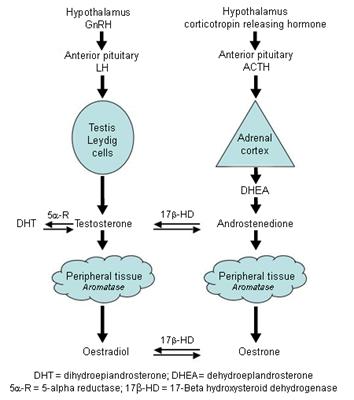
-Estrogen produced at peripheral sites is probably only biologically active in local tissue. This is where the aromatase enzyme is produced to convert circulating androgens (ANDROSTENEDIONE in women) to estrogen in tissues containing aromatase, which include:
Tests show that a fat lady after menopause makes more estrogen than a skinny lady before menopause
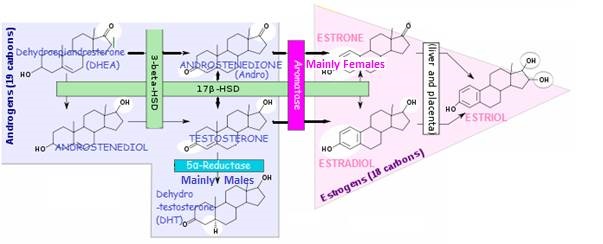
Androgens →Estrogens
Hemsell DL et al, 1975; Longcope Christopher et al, 1972
Tissues can draw on E1S as needed.
ANDROSTENEDIONE → ESTRONE (in women)
TESTOSTERONE → ESTRADIOL
Aromatase can be found in several tissues:

To see what substances increase or decrease aromatase production / activity:
What affects aromatase production/activity
Stanczyk F. 2001.

DIM Effect on Estrogen Metabolites
Comparative strengths of ESTRADIOL / ESTRONE / ESTRIOL
Estrogens (like all steroid hormones) readily diffuse across cell membranes, where they bind with estrogens receptors. This leads to the production of specific proteins that express the effect of estrogen upon the target cell.
Inactivated by PROGESTERONE
Activated by many physical and chemical conditions
Xenoestrogens -"Endocrine Disruptors"
Circulating Levels of estrogen
Aromatase is the main conversion enzyme d can be found in all parts of the body:
Aromatase activity (and therefore estrogen production) is affected by many factors:
A healthy liver combines estrogen with glucuronic acid ("sugar acid") to make it water-soluble for elimination. In the 1940's, the Biskindsdemonstrated some causes of liver impairment that decrease its ability to excrete estrogen, including:
Water-soluble estrogen must be made oil-soluble to be able to enter cells and exert its effects through their lipid membranes.
Sulfatase
Beta-glucuronidase (found in inflamed tissue). Normally, the healthy liver combines estrogen with glucuronic acid to make it water-soluble for elimination. However, if it passes through inflamed tissue, the large amounts of beta-glucuronidase there remove glucuronic acid, converting inactive estrogen-glucuronides into active estrogen, which accumulates in tissue
Cristofalo VJ & Kabakjian J , 1975
Xenoestrogens -"Endocrine Disruptors"
Estrogen dominance treatment 1-2-3
In men and postmenopausal women, extragonadal sites are the major source for the LOW circulating ESTRADIOL, which is NOT a good indicator of tissue levels and is NOT the body's main driver of estrogenic activity. In fact, estrogen circulation levels actually reflect estrogen which has escaped from metabolism at extragonadal sites of production. For example, the estrogen responsible for breast cancer development, maintenance of bone mineralization and cognitive function is not circulating estrogen, but rather that which is produced locally at these specific sites within the breast, bone and brain, respectively.
Circulating, blood ESTRADIOL levels are actually higher in men than postmenopausal women -

(To convert: pg/ml->Ng/dl, divide by 10)
ESTRADIOL(E2) is transported in serum, reversibly bound to sex hormone-binding globulin (SHBG) and with less affinity, to albumin
The bioavailability of estrogens is modulated by their binding to the sex hormone-binding carrier SHBG
Exogenous oral estrogens stimulate increased SHBG production(in the liver cells), whereas androgens suppress SHBG levels(making E2 more bioavailable, since there is less SHBG to bind to).
75-85% of estrogen inactivation / clearance is by the healthy LIVER, the rest is cleared extrahepatically. Contrast this to the androgens, which can also be significantly inactivated in other tissues;
The major route of estrogen inactivation is via the healthy liver's conversion of estrogen to ESTRONE. ESTRONE has only ~30% of ESTRADIOL's activity level (17BHSD in some peripheral tissues also makes this conversion). In the liver, ESTRONE is then dealt with by one of the following 3 methods:
The liver clears 0.70 - 0.85 liters/hr Longcope C et al, 1968
Blood flow in the liver appears important in determining the overall metabolic clearance of E2. Longcope C and Tait JF, 1971
One of the best ways to keep the liver functioning efficiently is by doing a coffee enema
Coffee Enema - "A Trash Truck"
For other liver detoxification methods:
How to reduce body's estrogen levels
Once inside the cell,an estrogenic hormone binds to estrogen receptors (ERs) to activate them
Two types of estrogen receptors
Skin / Hair follicle receptors. ER-β (and not ER- α) is the main mediator of estrogenaction in human skin and the hair follicle. ER-β is highly expressed in epidermis, dermal fibroblasts, and outer root sheath of the hair. http://www.nature.com/jidsp/journal/v8/n1/full/5640100a.html
HUMAN |
ER-α |
ER-β |
AR |
PR |
| Epidermis | ER- β | |||
| Dermal fibroblasts | ER- β | |||
| Outer root sheath of hair follicle | ER- β | |||
| Dermal papilla cells | ER-α | AR | ||
| Sebaceous glands | ER-α | ER- β | AR | |
| Eccrine sweat glands | ER- β | AR | PR | |
| Adipose Tissue(subcutaneous) |
ER- β |
Binding affinity of different estrogens
ER amounts ▼ decrease significantly after menopause
ESTRADIOL increases number of ER- α and AR receptors
Also, even a low dose of the synthetic estrogen bisphenol A (prolific in our world and bodies today - see xenoestrogens) has the same effect as natural ESTRADIOL. Richter CA etal, 2007
Stimulation is blocked by estrogen receptor antagonists - E.g. PROGESTERONE , tamoxifen,
ESTRADIOL is a relatively potent androgen receptor (AR) binder; Nakia et al, 1997; Richter CA etal, 2007
Estrogen and the ERs are implicated in breast cancer, ovarian cancer, colon cancer, prostate cancer and endometrial cancer - Advanced colon cancer is associated with a loss of ER-β, the predominant ER in colon tissue, and colon cancer is treated with ER-β-specific agonists. Harris et al, 2003
A test result of ER-positive (ER+) - means that ERs are "over-expressed" and that estrogen is causing a tumor to grow. ER+ tumors are slightly slower-growing than ER- tumors, and the cancer should respond well to hormone suppression treatments.
ERs and Breast Cancer. Test results show ER+ in ~ 70% of breast cancer cases
ER- α is associated with more differentiated tumors. ER-β involvement is controversial.
Different versions of the ESR1 (Estrogen Receptor 1 protein coding gene) associated with different risks of developing breast cancer. Deroo BJ and Korach KS, 2006
Mainstream endocrine therapy. Anti-estrogen therapy works by blocking the hormone receptors, preventing them from signaling the cancer cells to grow. Some commonly used ER antagonists in breast tissue:
Selective estrogen receptor modulators (SERMS):
Selective estrogen receptor down-regulator (SERD):
Some commonaromatase inhibitor drugs (prevent conversion of androgens to estrogen) - only useful for postmenopausal women, because postmenopausal women get most of their estrogen from the conversion of androgens into estrogen by the aromatase enzyme, while premenopausal women get most of their estrogen; directly from their ovaries;
Cristofalo VJ & Kabakjian J (1975) Mech. Ageing Dev. 4, 19-28.
Deroo BJ, Korach KS (2006). "Estrogen receptors and human disease". J. Clin. Invest. 116(3): 561-7.
Hall G, Phillips TJ. Estrogen and skin. The effects of estrogen, menopause, and hormone replacement therapy on the skin. J Am Acad Dermatol 2005;53:555-68.
Hemsell DL et al, Plasma precursors of estrogen II. Correlation of the extent of conversion of plasma ANDROSTENEDIONE to ESTRONE with age. J. of Clin End. And Met, 1974;
Longcope C, Layne DS, Tait JK. Metabolic clearance rates and interconversions of estrone and 17beta-ESTRADIOL in normal males and females. J Clin Invest. 1968 Jan;47(1):93-106. PubMed
Longcope C, Tait JF J Clin Endocrinol Metab. 1971 Apr;32(4):481-90.PubMed
Longcope Christopher et al, The secretion of ESTRONE and ESTRADIOL-17βby human testis, Elsevier Science Inc., 1972
Leslie Baumann. Cosmetic Dermatology: Principles and Practice, Second EditionMcGraw Hill Professional,Apr 8, 2009
Nachtigall LE,Raju U,Banerjee S,Wan L,Levitz M.Serum ESTRADIOL-binding profiles in postmenopausal women undergoing three common estrogen replacement therapies: associations with sex hormone-binding globulin, ESTRADIOL, and estrone levels. Menopause. 2000 Jul-Aug;7(4):243-50. PubMed
Nakla AM, Romas NA, Rosner W. ESTRADIOL Activates the Prostate Androgen Receptor and Prostate-specific Antigen Secretion through the Intermediacy of Sex Hormone-binding Globulin March 14, 1997 The Journal of Biological Chemistry,272, 6838-6841. Jbc Abstract
Richter CA, JA Taylor, RL Ruhlen, WV Welshons and FS vom Saal. 2007. ESTRADIOL and bisphenol a stimulate androgen receptor and estrogen receptor gene expression in fetal mouse prostate mesenchyme cells,. Environmental Health Perspectives, in press. Link
Stanczyk F. Estrogens used for replacement therapy in postmenopausal women. Gynecol Endocrinol. 2001;15(suppl 4):17-25.
Watson CS, Jeng YJ, Kochukov MY. Nongenomic actions of ESTRADIOL compared with estrone and estriol in pituitary tumor cell signaling and proliferation. FASEB J. 2008 Sep;22(9):3328-36. doi: 10.1096/fj.08-107672. Epub 2008 Jun 9. PubMed